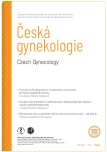Continuous glucose monitoring – a new and expanding element in the care of patients with diabetes mellitus during pregnancy
Authors:
Urbanová J. 1; Brunerová L. 1; Árská Janíčková Ž D. 2; Doničová V. 3; Brož J. 2
Authors‘ workplace:
Centrum pro výzkum diabetu, metabolismu a výživy, Interní klinika 3. LF UK a FNKV, Praha
1; Interní klinika 2. LF UK a FN Motol, Praha
2; Interná a diabetologická ambulancia, Výučbové centrum LF UPJŠ Košice, Slovenská republika
3
Published in:
Ceska Gynekol 2021; 86(6): 406-409
Category:
Review Article
doi:
https://doi.org/10.48095/cccg2021406
Overview
A new parameter of metabolic control derived from the results of continuous blood glucose monitoring is time in range (TIR). According to current recommendations, in pregnant women with diabetes, this glycemic range is defined by values of 3.5 to 7.8 mmol/L, with the aim of keeping glycemia in this range as much time as possible, and at the same time reducing the time spent below its lower limit (< 3.5 mmol/L). In pre-gestational type 1 diabetes, it is recommended to reach this TIR above 70% of the total measurement time including up to 4% of simultaneous time spent in hypoglycemia. In gestational (and pre-gestational type 2) diabetes, the recommended % of in-range times are not yet specified.
Keywords:
gestational diabetes – continuous monitoring glucose – glycemic control – time in range
Sources
1. Andělová K, Anderlová K, Bláha J et al. Gestační diabetes mellitus, doporučený postup screeningu, gynekologické, perinatologické, diabetologické a neonatologické péče 2017. DMEV 2018; 21 (3): 113–120.
2. Urbanová J, Brunerová L, Nunes MA et al. MODY diabetes and screening of gestational diabetes. Ceska Gynekol 2020; 85 (2): 124–130.
3. Holubová A, Vlasáková M, Mužík J et al. Customizing the types of technologies used by patients with type 1 diabetes mellitus for diabetes treatment: case series on patient experience. JMIR Mhealth Uhealth 2019; 7 (7): e11527. doi: 10.2196/11527.
4. Klonoff DC, Ahn D, Drincic A. Continuous glucose monitoring: a review of the technology and clinical use. Diabetes Res Clin Pract 2017; 133: 178–192. doi: 10.1016/j.diabres.2017.08.005.
5. Battelino T, Danne T, Bergenstal RM et al. Clinical targets for continuous glucose monitoring data interpretation: recommendations from the international consensus on time in range. Diabetes Care 2019; 42 (8): 1593–1603. doi: 10.2337/dci19-0028.
6. Hughes RC, Rowan J, Florkowski CM. Is there a role for HbA1c in pregnancy? Curr Diab Rep 2016; 16 (1): 5. doi: 10.1007/s11892-015- 0698-y.
7. Yu Q, Aris IM, Tan KH et al. Application and utility of continuous glucose monitoring in pregnancy: a systematic review. Front Endocrinol (Lausanne) 2019; 10: 697. doi: 10.3389/fendo. 2019.00697.
8. Scott EM, Feig DS, Murphy HR et al. Continuous glucose monitoring in pregnancy: importance of analyzing temporal profiles to understand clinical outcomes. Diabetes Care 2020; 43 (6): 1178–1184. doi: 10.2337/dc19-2527.
Labels
Paediatric gynaecology Gynaecology and obstetrics Reproduction medicineArticle was published in
Czech Gynaecology

2021 Issue 6
Most read in this issue
- The role of the microbiome in pregnancy
- Comparison of dinoprostone, misoprostol and amniotomy in labor induction
- Breast reconstruction in patients with BRCA mutation and breast cancer – our approach
- Covid-19 as a possible risk factor of intrauterine fetal death
